Photos by Willie Berríos (WB), Fernando Calzada (FC), Poli Marichal (PM),
Ricardo Méndez Matta (RMM) and Roxana Santiago (RS).
Click on each photo to enlarge it. (click again on the enlarged photo to download a high resolution copy)
November 2003 – The beginning
Knowing that the Puerto Rican Film Commission was about to announce a call for entries for the newly formed Puerto Rico Film Industry Fund, we sat down and started weaving three separate stories. Wanda’s came first, then we added Isabel and Luijan, and finally Migue and Marisol. Each one of them changed many times (originally Isabel was a man and Oscar was a corrupt cop), but eventually they all fell into place.
December 2003 – The first draft
The first draft we completed was named “The Corrupt Ones,” which we then changed to “Three Families,” and finally to “Thieves and Liars.” Poli thought it was not only in reference to the corrupt politicians in Wanda’s story and/or the smugglers in Oscar’s, but also to those who steal your dignity, or deny you the opportunity to get ahead, and to those who lie to a loved one, or lie to themselves and live in denial. If you look at it that way, practically all of the characters in our movie are “thieves and liars.”
February 2004 – We submit the project
After three months of hard work, and with the help of UPM Rosa González and producer Itzie Molini, we completed the proposal and turned it in. There began the most unpleasant aspect of the entire process: the wait.
June 2004 – We’re approved
When the Film Fund finally responded, Itzie was in Argentina producing commercials, Poli was in Los Angeles preparing an art exhibit, and I was in the Dominican Republic working as 1st AD for director Andy García on “The Lost City.” Fortunately, the news were good: the Film Fund had approved our project and had awarded us the maximum amount of financing allowed by law, $1.2 million. We were all ecstatic.
July in Santo Domingo -it was hot! That’s me on the left, followed by 2nd AC Pedro Guillén, Script Supervisor Carmen Soriano and Director Andy García. (FC) |

|

|
I even got to be in a scene with (right to left) Inés Sastre, Andy García and Jsu García. (FC) |
July 2004 – It all falls apart
Much to our chagrin, problems surfaced with our proposal which none of us could attend because we were all out of town working. We requested more time from the Film Fund, so that we could take care of the matter, but the Board of Directors chose to withdraw the financing and suggested we reapply in September. We were devastated.
September 2004 – We submit a second time
We took advantage of the unexpected delay to polish the script and put together a much more solid proposal. Our friend Laura Medina went over the budget, making it even more accurate and realistic, and this time the project was not submitted by an individual, but by a corporation (Ladrones y Mentirosos, Inc.), with Ellen S. Gordon as Line Producer. Our friend Eric M. Vega generously volunteered to preside the corporation, which meant he was stuck signing every one of the seemingly endless legal documents. Thanks, Eric!
November 2004 – We move to Puerto Rico
Anticipating the Fund’s decision was to come before the year’s end, we closed up our house in Los Angeles and rented a tiny beachfront apartment in Isla Verde, where we set up a mini office. At first I thought it was too small, but Poli corrected me, it was not “small,” it was “romantic” (we ended up using it in the movie as Marisol’s apartment).


This was the view from our 11th floor window (not bad!). (RMM)
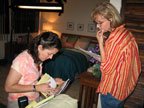

Poli and Script Supervisor Mónica Ochoa go over paperwork
as the electricians pre-rig our apartment. (WB)
It was actually pretty great, we could even see from our balcony manatees frolicking down below in the surf. Once established there, we started to seek actors and locations, as well as expanding our research into the drug trade in Puerto Rico.
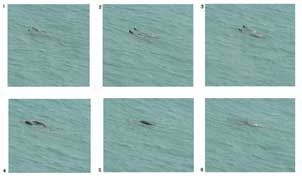
An adult manatee and her baby come up for air just below our apartment. (RMM)
By coincidence, we met agent Rafael “Pichy” Cabrera, of the Puerto Rico Police Department, who led us into every corner in the town of Fajardo where cocaine is being smuggled. He showed us everything: the docks where they bring it in, the special boats they use to navigate shallow waters, the tiny islands where they hide the drugs (Puerto Rico is actually an archipelago), and even the homes of the local “bichotes” (big shots). He pointed out a man working on a yacht at the dock in Las Croabas and said, “That’s one of the big smugglers in the area. I know it, but I haven’t been able to catch him yet.”

Rafael “Pichy” Cabrera shows Poli the exact spot in Las Croabas where he
had helped bust a drug smuggling deal. We pretty much recreated the
events (minus the bust)for the title sequence of our film. (RMM)

From this hilltop in Fajardo a smuggler with a pair of binoculars can keep an eye
on the entire coastline and easily update incoming boats via cell phone
on the location of any Police boat. (RMM)
As agent Cabrera explained, the drugs arrive in many ways, aboard luxury yachts, in small fishing boats, and in large cargo ships. Sometime the smugglers bury the kilos in predetermined spots in nearby deserted islands and spread the word to fishermen that they will be paid $1,000 for every kilo they bring in. After seeing it with our own eyes, we realized how it is practically impossible to stop the wave of illegal drugs entering our country.
December 2004 – We’re approved again
The Film Fund announced it had approved our project once again, but this time with a financing of $880,000, an unexpected 26% drop. Poli and I immediately appealed their decision, which further delayed us by another three months. On the one hand, we felt we were wasting time, but on the other hand, we managed to spend the Holidays with our family, which we had not done in years. We also continued polishing the script, using all the new information we were compiling.
Taking advantage that many Puerto Rican actors who live in the US were visiting the island for the Holidays, we set up casting auditions. Rather than have actors do a cold reading in an office, we set them up in pairs and have them improvise scenes at a real location (Poli’s Mom’s house). We treated the auditions as if they were principal photography: Jaime photographed them with the same camera we were going to make the movie with (the Panasonic DVX100A), I rented some lights from PJ Gaffers, Marisol "Ari" Oyola acted as AD, and we hired Margarita Aponte to do the sound. It is during these sessions that we decide to cast Dennis Mario and Carlos Paniagua.
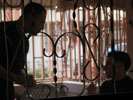
|

|
Improvising in pairs: Dennis Mario and Miguel González: Magda Rivera and Carlos Paniagua. (PM) |
January/February 2004 – The government changes
With the New Year came a new governor, Aníbal Acevedo Vilá, who in turn named a new cabinet. Amongst the new faces was Luis Riefkohl, the new Executive Director of the Puerto Rican Film Commission, which also now had a new Board of Directors. This had the effect of further delaying our appeal, while the new Board members got up to speed. Poli made the most of the wait, participating in the First Women in Film Festival, held in San Juan, with two short videos, “Women of Juarez” and “From my Eyes.”
March 2005 – The financing increases
We made the first of several presentations to investors, screening a short video teaser, illustrating the style and themes of our movie, and our attorney Antonio Sifre explained in detail how the tax credits work. We did pretty well for first timers, selling twelve stock offerings at $10,000 each. Within a few days, the Film Fund’s Board of Directors finally meets and decides to augment their share of the financing to $1.03 million, which is less than they had given us before, but more than they’ve given any other film. After a meeting with Luis Riefkohl, Poli and I decide to accept their offer.
April 2005 – Pre-production
We opened up offices at the old Tony Vera photo studio in the Santurce neighborhood. The place is perfect, central and roomy, and it even has a makeup room, which will save us renting a trailer. The locations are all (mostly) settled.

|

|
The Locations Department: Sofía Tirado, Paola Cambó and Raquel Medina. (RM) |
Line Producer/UPM Ellen S. Gordon and DP Jaime Costas go over the camera budget. (RM) |
The actors begin to prepare their parts: Steven and Lymari train with agent Cabrera, Magda spends her days at the airport and Elpidia meets with real life reporters Oscar J. Serrano and Omaya Sosa Pascual. It was much easier for Dennis Mario, as we were going to film at his art studio and with his jazz band, Kobana Negra (the paintings you see at the studio and at the concert are actually his, and the song you see the band play, “Guasábara,” was written by Dennis).



Dennis Mario: painter, musician, and now actor. (WB)
Little by little we sell a few more stocks, and Poli and I purchase the remaining ones. With the production ready to go, we undertook a loan of $150,000 in order to avoid any delays while we wait for the Fund’s money to arrive. Nothing was stopping us now.

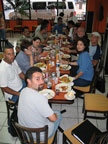
While Michelle “Michi” Rodíguez and Sara Arroyo hold down the fort at the office,
the crew enjoys a mofongo lunch during a location scout. (RM)
May 2005 – The filming begins
We started shooting on the 1st of May. The $1.4 million budget allowed for twenty-four days, but we scheduled only twenty-three, thinking something was bound to happen and we would surely fall behind a day. A week into filming, Monica Ochoa, our continuity person, assured us the movie was running long. The shooting script only had 105 pages, but we listened to Monica and cut another six pages off the script.





We had a terrific grip and electric crew: among them Gaffer José “Junior” Alvarado, Key Grip Francisco Román, Raymond Orraca, Félix Núñez and Emmanuel Carrión.(WB)
The shooting schedule was done by story, and in script order whenever possible. We did so inspired by Ken Loach, with whom we had worked on “Bread and Roses” in 1999. He always shoots in script order, and doesn’t hand out full scripts to his cast, but rather only the beginning, and then doles out pages scene by scene as the shooting progresses. The idea is to have everyone “live” the story rather than fake it. He also gets rid of everything that can turn a location into a “set,” such as director’s chairs, video monitors, etc., and he also avoids cranes, dollies and steadicam. There are no rehearsals, and there are no marks on the floor telling the actors where to stand. When the cast arrives at the set, they find the bare minimum crew and equipment. It’s a wonderful working method, quiet and without interruptions or distractions. At first some in the crew were a little hesitant, but eventually everybody got used to it.



The ideal set is no set at all: as few crewmembers as possible (Director, DP, AC,
Script and Boom only) a minimum of lights, little or no unused equipment laying about,
and no observers whatsoever. (WB)
We began with Wanda’s story at the airport, one of our most difficult days. Poor Magda had to start right off the bat with some of her heavier scenes, but with faith and patience everything moved forward. That first day was a real test for all the departments, but luckily between Ellen Gordon and ourselves we had assembled a great team, which instead of bowing under pressure, got even stronger.



Magda’s first day of shooting was one of her most difficult. (WB)
The toughest thing about Wanda’s story ended up being getting permission to shoot inside a courtroom. The State Court system said no, in spite of our offer to shoot at night, or during weekends, and in any town they wished. The Federal Court was much more open but, just our luck, some nut pulled a gun and shot a marshal in a courtroom in Atlanta, which meant all federal courts went on orange alert, and we were denied our permit. The Interamerican University had a court classroom that looked pretty good, but our dates conflicted with their final exams. For a moment we thought the State Court was going to reconsider, but at the last minute they went back to no. So we were forced to build a courtroom set within the Natural Resources building, which was pretty much empty. Monica Monserrate, Jean P. Rubio and the entire art department locked themselves up in a window-less room for three days, until they built the set you see in the film. It cost us thousands of unbudgeted dollars, but at least we had the satisfaction of shooting all of our scenes in spite of the lack of cooperation from the Courts.



(L) Production Designer Mónica Monserrate built us a fantastic set, which looked even better when (C) the Méndez/Matta families showed en force to fill it up. Also invaluable was the technical assistance of (R) real plaintiff Wanda Vélez, here visiting the set, and real-life attorney Salvador Tió, who played Carmona’s lawyer (WB).
With our goal of making everything as natural as possible, two real-life lawyers were hired as actors: Juan Palerm Nevares and Salvador Tio. We also hired law student Rafael Alvarez, as well as a real-life bailiff and court stenographer. We had yet another attorney set to play Judge Cancel, but he suddenly cancelled because, in his words, “there are some really bad people out there, and my friends are advising me not to take this job.” We were surprised that anyone would be so worried about our movie that they would scare off our actors, but all we could do was thank him for his honesty and accept his resignation. Fortunately, Rene Monclova agreed to play the part, so we ended up ahead.



René Monclova, Rafael Álvarez and Julio Torresoto were among the few real actors
in the courtroom scenes. (WB)


University professor Carlos Marichal and real-life attorney
Salvador Tió had never acted before. (WB)
Since the cast did not have full scripts, Magda had no clue how her story ended. She had met the real Wanda Velez, and had visited the airport, but everyone was careful not to tell her too much. When the moment came on the set, and Magda finally heard the words “typographical error,” her face dropped in shock, and I remembered having felt the same when I witnessed the actual hearing in which the scene was based. In fact, many details in that scene were lifted from real life, like the Comptroller’s assistant sitting in the crowd, and the “original notes” that no one bothered to look at. Truth is stranger than fiction.




Other key crew members: ACs Roxana Santiago and Fernando Rosado,
Key Makeup artist Edna de Jesús, Hairdresser Margarita Jeannot. (WB)
The second story to begin filming was that of the reporter and her son. Seeking realism, we hoped one of the local newspapers would allow us to use their name and their facilities. “Isabel” was based on three actual reporters, Oscar J. Serrano, Omaya Sosa Pascual and Mario Alegre (who, like Isabel, is Mexican), but even so, we couldn’t get a newspaper to go along. Once again, the art department had to come to the rescue and build us several sets.



The newspaper scenes were shot inside the old Zaga Films offices
(the painting behind Magda is by Poli). (WB)
One of the first Isabel scenes to shoot was when she confronts her son with the baggie full of marihuana. Carlitos Paniagua didn’t have a script, and his dialogue was going to be improvised. So it was up to Elpidia Carrillo, the veteran actress who did have a script, to steer the scene. Everything went well (after all what teenager today doesn’t know of a similar episode), but the real surprise came when Elpidia suddenly became furious and slapped poor Carlitos really hard. Once we cut, we asked her why she did it, to which she replied, “He wouldn’t shut up!” It was brilliant, but it did make Isabel seem a bit too hard, so we asked Elpidia not to do it in further takes.

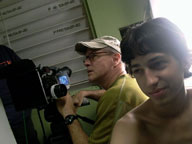
Veteran Mexican actress Elpidia Carrillo was a great help to
newcomers Dennis Mario and Carlos Paniagua. (WB)
But the toughest moments in this story were the ones having to do with Luisito’s arrest. When we did the scene with the cocaine in the car, neither Carlitos nor Aris Mejias knew they were getting busted. The cop was a real one, agent Orlando Colon, who asked us how we wanted him to conduct the arrest. Poli and I told him to do it just the way he normally does it, and he improvised everything you see on screen.



The arrest and police station scenes were filmed in one long night
(the tired look on our faces is for real). (WB)
That same night, or rather the next morning, we did the jail scene. Our permit was for filming strictly outside the police station, but when we got there it was raining. Luckily, the cops were very kind and let us shoot inside. By the way, this film could not have been made without the unselfish help of several agents of the Puerto Rico Police, who had the courage and the vision to cooperate with us knowing that our film spoke of corruption within their department. They did it because they understood, as did we, that in order to fix any problem you must first recognize it. We felt very proud to have worked with individuals who, in spite of having to live daily in that world of drugs and corruption, and having to face temptation every day, still believe in truth and justice.
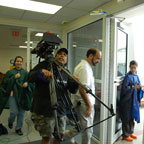

It was raining steadily at the Police station. Luckily, the cops let us shoot inside. (WB)
The last story to go before the camera was Migue, Marisol and Oscar. Of the three, it’s the one with the most fiction, although “Cheo” and Migue” are based on two former neighbors of Poli’s who were tragically murdered in the same prison you see in the film.
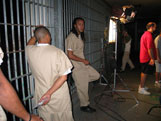


The jail scenes were shot at a real prison, using real policemen
(the prisoners -and the knife- were fake). (PM)
When we shot the scene in the overgrown field, Gilberto Concepcion Suarez didn’t know what was going to happen. After a few takes, I saw his shoes and pants were covered in mud and commented I hoped those were all wardrobe, and Gilberto answered: “All but the shoes. Those are mine.” Lucky for us, Gilberto has a great sense of humor, and accepted our apologies for the “abuse” at the hands of Steven, Pichy and Joseph Pinella, who left dark bruises all over his arm.

"The Killers": Agent Rafael “Pichy” Cabrera, Gilberto Concepción Suérez,
Steven Bauer, Agent Joseph Pinella, and José Heredia. (WB)
All scenes pertaining to the drug trade were shot at locations where they occur on a daily basis, in and around the northeastern city of Fajardo, one of the hottest drug smuggling spots in the island. During the filming, a woman walked up to us, with her eyes fixed on the bails of cocaine, and asked Poli: “Are those for real?” When Poli answered no, she replied, “Good, because if they were, I’d kill all of you and keep them.” When we shot the scene where the fishermen drag a fuel tank out of the brush, the two men we had hired jumped to say, ”That’s not how you hide it,” and proceeded to bury it under an abandoned sofa and some palm fronds. “That’s how you do it,” they said proudly.



Faces in Fajardo: (L to R) one of our fishermen (WB); Arturo Paredes and Mónica are swarmed by local kids (PM);Locations Assistant Raquel Medina poses with even more kids (WB).
The tile sequence, filmed in nearby Las Croabas, was a recreation of a drug buy Pichy had helped bust some years back. We found it interesting to learn that drugs can arrive in broad daylight, and not at night in some deserted beach, as we previously thought. Two DEA agents, who it turns out had also participated in the original bust, approached us while we were filming the scene and asked what we were doing. When we explained it was only a movie, they said they had noticed how much the scene resembled the original operation. They also told us that one of the passersby that had pulled over to watch the filming was actually one of the big drug lords in the region, who may have been equally curious about the goings on.
During one of our days in Fajardo, we were caught in a huge rainstorm on our way to the set, and found ourselves stuck in a flash flood that overtook the avenue. There we were, 1st AD Carlos de la Torre, Monica Ochoa, Poli and I, at five in the morning, in the dark, with the car stalled. After a while, a brave policeman waded into the waters and pushed our car out to dry land. Within hours of being caught in the downpour -this only happens in the Caribbean- the sun came out and we shot the rest of the day without a hitch, other than the water turning brown at the marina and the river, and of course the car that ended up being a total loss (yes, we were insured).



It rained heavily on our first day in Fajardo, but it stopped just in time to complete
the filming. (L to R) 1st AC Fernando Rosado and boom man Luis “Peco” Landrau focus
on the ice chest full of money (WB); towels hide thename of the smuggler’s boat (WB);
and Steven Bauer waits as Co-DP Willie Berríos lines up a shot (RS).
Agent Cabrera also helped us stage the police stakeout of a cocaine buy at a small bar. All the police working the scene were real Puerto Rican PD, and everything you see them do in the film is actual police procedure. We were a little unlucky with the weather, as it poured heavy rain that afternoon, making the scene very difficult to shoot. On the other hand, we were very fortunate to have reggaeton singer Vico C amongst the cast. His positive energy and easy-going demeanor made it all better.

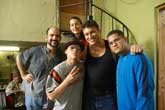
The rain gave us a good soaking outside the bar,
but everything got better once we moved inside. (WB)
Eventually the month of May came to an end, and with a lot of luck, and even more hard work from everybody, the feared delay never materialized and we wrapped in twenty-three days, a full day ahead of schedule. One of the main reasons we managed to achieve that was the 2nd Unit that Poli directed and Willie Berríos photographed. The “Poli-Willie” unit was responsible for many of the more memorable moments in the movie, such as the smugglers reflected in the water, Cheo alone in the rain at the jail, the security bars montage, all the seascapes, and all the urban images of graffiti and traffic jams. The 2nd Unit not only got us ahead, they also added a certain poetic element to the film.
June 2005 – It’s over
The wrap party was at beautiful Piñones beach, where we downed a few cold ones and listened to Steven Bauer play the guitar and sing “Twist and Shout,” “La Bamba,” and many other classics. TNT also got in the groove, improvising a “Thieves and Liars” rap. Maybe it was the beers, but it really felt great to finally relax with such a cool and united bunch of people. Hopefully we'll be able to do another movie soon.



The cast and crew finally enjoys a few well deserved cold ones at the beach.
After a very stressful month (I lost nearly 20 pounds), Poli and I began packing to return to Los Angeles. Moving after being somewhere for seven months is not easy, and even after tossing a bunch of stuff, we still had to mail 29 boxes to ourselves. Leaving was very sad, as we had totally gotten used to living in Puerto Rico again, and we had no desire whatsoever to trade our beautiful Isla Verde beach for the freeways in L.A.
July 2005 – We have to cut scenes
As soon as we got going with the editor, our Argentine friend Martin Singer, we realized that even after cutting the script down we still had a very long movie. So we started the unpleasant job of eliminating scenes, which to writers/directors is akin to Sophie’s choice. Gone is Luijan speaking to students, gone is Migue talking to his junkie dad, and gone is Wanda busting her daughter with a boyfriend. It really hurts to cut them, and the only consolation is they’ll all be back when the special edition DVD comes out.




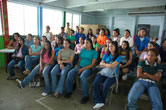

Images from several of the deleted scenes. (WB)
It was also very hard to work on the score with Superaquello via long distance. Lucky for us, Eduardo Alegria had great faith in our project, and even more patience with the process, which was as new to us as it was to them. We worked using the Internet, exchanging QuickTime movies scene by scene, until everyone was happy. Hiring a composer in L.A. would have been much more practical, but it was very important to us that the music come from Puerto Rico (plus we love the Superaquello sound!).
August 2005 – The previews begin
We held several screenings at our house for friends and colleagues, using a DVD made from the AVID. The quality was not good, but we had to get some feedback. It ran a little over two hours, and nearly everyone who saw it said it was too long, and that juggling between the three stories was a little confusing. Martin, Poli and I cut even more out, restructured the whole thing, Our dining room table was covered with index cards, each describing a scene or sequence, and we kept reshuffling them until we reached a stronger and more cohesive structure. Magda and Steven saw the new cut and loved it. Poli and I began to feel we have a movie.
 Editing at home made a huge difference. (RMM)
Editing at home made a huge difference. (RMM)
September 2005 – We lock picture
With a lot of hard work, we manage to cut another 16 minutes off the movie and gave it a new order that everyone finds agreeable. After a few screenings where no one complains about the length anymore, and everyone seems to like it (including Lymari and Edward James Olmos), we lock the picture and turn it over to Mission Post for all the sound work. Jaime Costas flew in from San Juan and together we did the digital color correction at Westwind, in Burbank.
October 2005 – The sound
While Paul Stanley, Jesse Pommeroy and the folks at Mission Post finish prepping the other sound elements, we did some looping (or ADR). We held a session in Hollywood first (where we also recorded a loop group featuring three Puerto Ricans, two Cubans and a Dominican) and then Poli supervised a second session at Alfa Recording, in San Juan. Some actors find looping difficult, but Steven Bauer is truly terrific at it. He blew right through his lines with the greatest of ease.
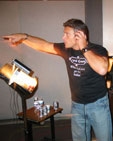


Looping: Steven Bauer, Magda Rivera and Elpidia Carrillo take a crack at it. (RMM)
Luis Riefkohl visited L.A. for the American Film Market and we got together for a gathering held by the Film Commission at a Santa Monica bar. There we met up with Roberto Busó, Pedro Muñiz, Marcos Zurinaga and many other Puerto Rican filmmakers. I could also see first hand the great interest sparked by the tax credits being offered in Puerto Rico. If all goes well, we may see a great increase in local production. I hope so.
November 2005 – The final stages
We mixed the film at Monkeyland Audio, with Sergio Reyes and Andy Hay at the controls. Sergio is a great veteran, and kept us laughing with his anecdotes from “The Wild Bunch,” “The Abyss,” and “Sin City.”

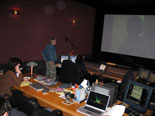

Mixing at Monkeyland: (L) Andy Hay listens to some backgrounds (RMM), (C) Poli oversees the mix (RMM), (R) Andy, Sergio Reyes and Paul Stanley check out the playback (PM).
On the final day of the mix, we finally received a CD with the final version “Nadie se Atreve,” the song by Cultura Profética that plays over the final credits. The song is awesome, and everyone was impressed, asking who the band was and where they could buy the CD. This final version was a tad longer than the original demo we got from Omar Silva, but we decided to stretch the credits to match the song, so we wouldn’t have to cut a single note.
With the sound all done, we went to Fotokem to screen the 35mm blow up that Gilbert Yablon and FilmOut Xpress had done from our Mini DV original. We were pleasantly surprised with the image quality, particularly the colors. Gilbert had been highly recommended by Sergio Arau, with whom he had done “A Day Without a Mexican,” and the truth is that now we too can recommend him as well.
December 2005 – The trailer
With everyone taking off for the Holidays, we got back together with Martín to cut a trailer. After working on it for a bit, we realized there would have to be two different versions, one for Puerto Rico and another for foreign markets. Drugs and corruption may sadly be universal themes, but it’s still true that Puerto Ricans will see things in our movie that no one else will see.
January 2006 – A finished print
We created the titles in video, Gilbert shot them on film and, with a negative cut, they were incorporated into the print, resulting in the very first 35mm copy of our movie. After adding subtitles in English (written by us), we held a screening for the cast & crew who live in L.A. We were very anxious to see how people would react, specially knowing we had a mixed group of Americans and Puerto Ricans. But the audience reaction was great, they laughed and gasped when they were supposed to, and stayed long after the screening was over telling us how much they liked it. The next two days the phone rang off the hook, with more and more positive comments coming from many different kinds of people. Poli and I finally breathed a sigh of relief.

